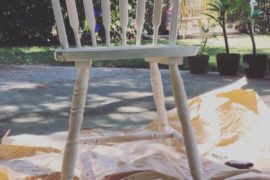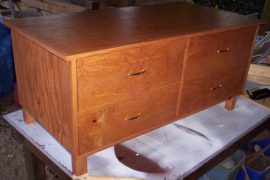Once the furniture has been washed and treated with Moses T’s Reviver and any necessary filling is done, it is ready for touch ups. Touch ups are done only in areas where the finish is missing or damaged. Touch ups can be done with dry powdered pigments and a variety of vehicles. The pigment can be used With Moses T’s St. John’s Oil, with shellac, with paint or varnish or in paste wax depending on the requirements.
If the finish is in good shape but a few minor holes need to be filled then paste wax is chosen. Enough beeswax to fill all of the holes is formed into a ball with the fingers and touched into the powdered pigment until the exact color match is achieved. The wax and pigments are mixed by kneading the ball of wax with the fingers. It is then forced into the holes and can be smoothed with a smooth putty knife, pallet or painting knife. If the was / is not the same color as the original then it should ere to the lighter side and can be touched up later. The wax is then buffed with a clean cloth moistened with Moses T’s St. John’s Oil if a satin finish is desired or St. John’s Wax if wax protection is required or with Moses T’s Gunstocker’s Finish to achieve a high gloss.
Pigmented wax repairs or touch ups might be all required after treatment to complete a restoration. Sometimes it is done before any other finish work is done. But it can also be done after the finish is completed. Pigmented wax is a versatile repair tool that can be taken into the field and serviceable repairs accomplished without moving the furniture. The wax repairs are buffed with a clean cloth to match the shine of the surrounding finish.
The dry powdered pigments can be mixed with white oil based paint to match the surface being touched up. White latex paint also works. This technique is used to cover marks that cannot be removed or that do not respond to treatments. Cigarette burns and holes filled with wood putty as well as dark stains are candidate for pigmented paint touch ups. The pigmented paints are used to physically cover the unsightly marks. They are applied with a small brush and done in the same direction as the grain of the wood or in the manner of the original finish if it is painted.
Wood is usually more than one color so the first touch ups are done with the lightest color first. This is allowed to dry and the darker marks of the pores of the wood are put on by adding some burnt umber or black to the previously pigmented paint touch up. If the touch ups are dull and not as shiny as the surrounding finish then a final coat of one of Moses T’s Fine Finishes will bring all the surfaces to the same shine and luster. If a touch up is particularly dull then a light coat of shellac can add the needed shine; if the touch ups are too shiny then whiting or rottenstone can be added to paint or shellac to dull the finish.
Pigments can also be added to clear varnish to color it when the opaqueness of white paint is not required.
Pigments can also be added to Moses T’s St. John’s Oil to provide an oil based stain. Once a piece has been treated with Moses T’s Reviver they any lighter areas can be stained with pigmented St. John’s Oil. Enough oil to do the staining is mixed with just enough pigment to provide the exact color match. It is rubbed on in the direction of the wood, allowed to dry for 10 minutes and the excess wiped off. If should be allowed to dry at least overnight before any finish work or further staining is done.
Pigmented St. John’s Oil can also be used to stain wood that has been previously stripped. The stripped piece should be treated with Moses T’s Reviver prior to staining. This is done to replace the moisture that is removed by the harsh stripping process. This also ensures that the pigmented St. John’s Oil will absorb evenly. End grain wood will absorb more stain than the side grain, so if it is previously treated with Reviver, the stain will absorb more evenly.
If a piece of antique furniture needs a part or two replaced it will need to match the old wood and finish. All wood turns either red or yellow with age. Walnut becomes lighter with age. When replacing parts the first stain should be red or yellow to add artificial age before the matching stain is applied.
Some surfaces might be bleached out by exposure to sunlight. Pigmented St. John’s Oil can add the proper color back to the faded colors of the wood or finish. If a darker color is needed then the process should be repeated with thin coats only until the desired finish is achieved. Do not allow a thick coat of pigmented St. John’s Oil to dry on the surface; either add more pigment to the oil or use pigmented shellac. Two or three thin coats are better than one thick coats.
Pigmented shellac is one of the most versatile touch up materials. It can be applied in a thin even coat or built up to fill in missing or to fill small holes. It is easily removed with more shellac or alcohol. In museum terminology it is reversible.
Pigmented shellac can be used for a variety of finish repairs. Plain non pigmented shellac can be used to make previous touch ups shine. Rottenstone or whiting can be used with shellac to produce a non shiny (matte) finish. The degree of dullness is directly proportional to the amount of rottenstone or whiting. More – dull and less – shiny. If wood is being touched up then the same process as described with pigmented paint is followed. The lightest color pigmented shellac is applied first, followed by the darker pigmented shellac. If a white or clear finish needs to be touched up then the clear varnish or bleached shellac is used. It may be slightly colored with dry powdered pigments to match the desired light or clear finish.
At times it is necessary to smooth the finish or touch up with fine 600 grit sandpaper. This should be done wet, in other words with a little St. John’s Oil on the sandpaper. This lubricates the surface being sanded and reduces heavy scratching on fine surfaces.
If a piece of furniture has been over painted and is stripped, sometimes paint is left in the grain or in cracks or corners. Instead of trying to remove the fine lines of bright paint in the grain of dark oak for example, it is easier to touch up the light paint with umber pigmented shellac and a small brush. At times a brown colored pencil can prove indispensable in covering blemishes such as paint in cracks or open grain. If a light coat of shellac is placed over the touch ups or the entire surface, the pencil marks become permanent and will not rub off. Orange shellac can be used for darker woods and bleached shellac or clear varnished can be used for lighter colored woods and finishes.




